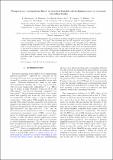Files in this item
Temperature tuning from direct to inverted bistable electroluminescence in resonant tunneling diodes
Item metadata
| dc.contributor.author | Hartmann, F. | |
| dc.contributor.author | Pfenning, A. | |
| dc.contributor.author | Rebello Sousa Dias, M. | |
| dc.contributor.author | Langer, F. | |
| dc.contributor.author | Höfling, Sven | |
| dc.contributor.author | Kamp, M. | |
| dc.contributor.author | Worschech, L. | |
| dc.contributor.author | Castelano, L. K. | |
| dc.contributor.author | Marques, G. E. | |
| dc.contributor.author | Lopez-Richard, V | |
| dc.date.accessioned | 2017-10-19T14:30:13Z | |
| dc.date.available | 2017-10-19T14:30:13Z | |
| dc.date.issued | 2017-10-21 | |
| dc.identifier | 251388966 | |
| dc.identifier | 1d74a818-2b5f-4834-b3af-15b899edb259 | |
| dc.identifier | 85031920752 | |
| dc.identifier | 000439584800009 | |
| dc.identifier.citation | Hartmann , F , Pfenning , A , Rebello Sousa Dias , M , Langer , F , Höfling , S , Kamp , M , Worschech , L , Castelano , L K , Marques , G E & Lopez-Richard , V 2017 , ' Temperature tuning from direct to inverted bistable electroluminescence in resonant tunneling diodes ' , Journal of Applied Physics , vol. 122 , no. 15 , 154502 . https://doi.org/10.1063/1.4994099 | en |
| dc.identifier.issn | 0021-8979 | |
| dc.identifier.uri | https://hdl.handle.net/10023/11888 | |
| dc.description | The authors are grateful for financial support by the BMBF via national project EIPHRIK (FKZ: 13N10710), the European Union (FPVII (2007-2013) under grant agreement no. 318287 LANDAUER), and the Brazilian Agencies CNPq and CAPES. S. H. gratefully acknowledges support by the Royal Society and the Wolfson Foundation. | en |
| dc.description.abstract | We study the electroluminescence (EL) emission of purely n-doped resonant tunneling diodes in a wide temperature range. The paper demonstrates that the EL originates from impact ionization and radiative recombination in the extended collector region of the tunneling device. Bistable current-voltage response and EL are detected and their respective high and low states are tuned under varying temperature. The inversion bistability of the EL intensity can be switched from direct to inverted with respect to the tunneling current and the optical on/off ratio can be enhanced with increasing temperature. One order of magnitude amplification of the optical on/off ratio can be attained compared to the electrical one. Our observation can be explained by an interplay of moderate peak-to-valley current ratios, large resonance voltages, and electron energy loss mechanisms and thus could be applied as an alternative route towards optoelectronic applications of tunneling devices. | |
| dc.format.extent | 6 | |
| dc.format.extent | 357828 | |
| dc.language.iso | eng | |
| dc.relation.ispartof | Journal of Applied Physics | en |
| dc.subject | QC Physics | en |
| dc.subject | NDAS | en |
| dc.subject.lcc | QC | en |
| dc.title | Temperature tuning from direct to inverted bistable electroluminescence in resonant tunneling diodes | en |
| dc.type | Journal article | en |
| dc.contributor.sponsor | The Royal Society | en |
| dc.contributor.institution | University of St Andrews. School of Physics and Astronomy | en |
| dc.contributor.institution | University of St Andrews. Condensed Matter Physics | en |
| dc.identifier.doi | 10.1063/1.4994099 | |
| dc.description.status | Peer reviewed | en |
| dc.identifier.grantnumber | n/a | en |
This item appears in the following Collection(s)
Items in the St Andrews Research Repository are protected by copyright, with all rights reserved, unless otherwise indicated.

